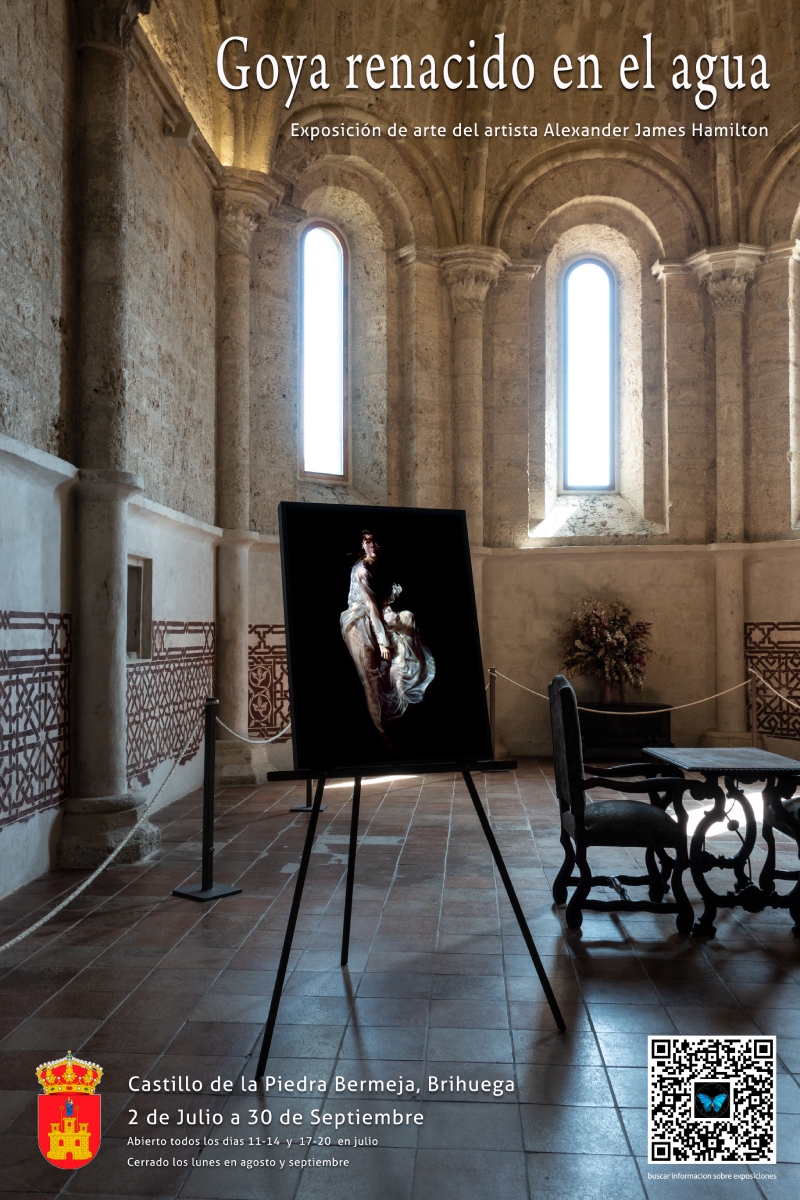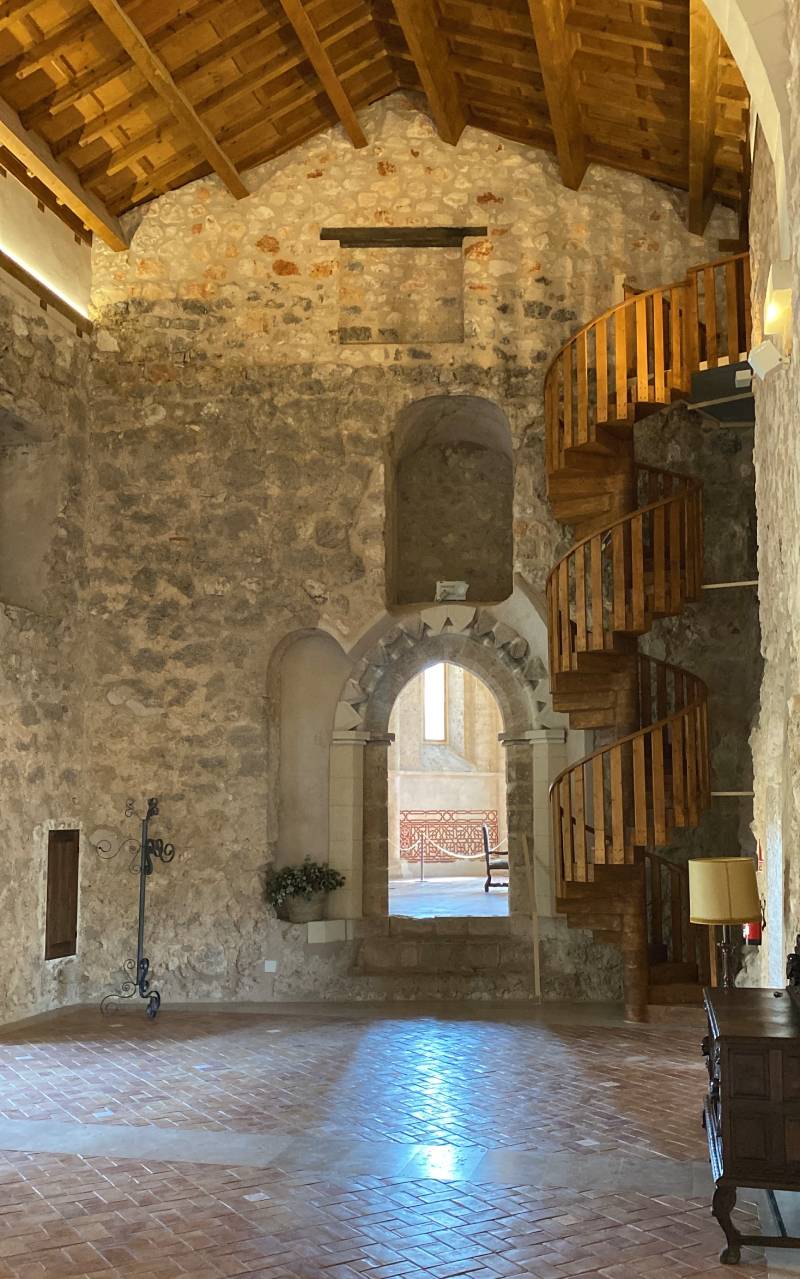Francisco De Goya - reborn in water exhibition in the 10th century Castillo de la Piedra Bermeja
Author: Distil Ennui | Post Date: 25-06-2025PRESS RELEASE... ´ Goya Reborn In Water ´
Castillo de la Piedra Bermeja Brihuega.
5th July 2025 until September 30th. open 7 days a week 11-2pm & 5 to 8pm.
closed mondays in August & September.
the PDF catalogue for the exhibition can be downloaded in ENGLISH & SPANISH.
see the available artworks here
´Renaciendo´ began in 2020 within the solemn ruins of the Baroque Convento de Los Carmelitas in Budia, Alcarria, where Alexander James Hamilton reopened a site abandoned and disused for over 150 years. In that first iteration, Hamilton collaborated with the local community to clear debris, stabilise the floor, walls & porticos, and then hand-fabricated a minimalist museum standard lighting system, made exclusively from recycled scrap aluminum drinks cans from the village and surrounding landscape. This lighting system was donated by the artist to preserve the building and ensure its future cultural use.
Following the exhibition and the artists stewardship, the convent’s architecture can now once again be restored to its original form and host culture projects of important for the region including art projects to allow young artists to engage with the space and invite the public in.

As Hamilton himself described, ´Reborn´ serves as both a poetic testimonial to the vitality of our cultural landscape, past and present, and to become a beacon of his ´3R Strategy´ (Reduce, Reuse & Recycle) urging a spiritual re-awakening with nature.
Renaciendo in Budia included large format photographic works created by collecting detritus and unwanted items from coral reefs, up-cycling plastic pollution into hauntingly beautiful underwater PhotoGrams, a camera-less technique that articulates the tension between destruction and hope. Contemporary art, Hamilton argued, often uses shock & PR tactics to get ahead, Alexander believes contemprary art should not only be beautiful, but also convey profound messages about our fragile relationship within the environment, rivers & oceans.
Professor Javier Poyatos Sebastián, Prof. Teoría de la arquitectura y la ciudad, Universidad Politécnica de Valencia cited The Renaciendo in Budia project as exemplary “creative ruralism,” observing that “the exhibition constitutes a hymn to a natural world that is disappearing and a denunciation of industrialisation and the pollution of the oceans… In a fascinating space of an ancient religious order… Something magical happens… especially at dusk”. His reflections highlights how Hamilton’s site-specific intervention transformed a ruined convent into a living artwork: the Baroque shell became both container and collaborator in an ecological and cultural critique, where shifting daylight, artworks & lighting system created a poetic dialogue with the decaying masonry.
In Castillo de la Piedra Bermeja, perched atop its vermillion-hued rock south of Brihuega, Hamilton’s underwater religious portraits find a new resonance within medieval stone vaults and narrow apertures. This fortress, originating as an Arab stronghold between the 10th and 11th centuries and later expanded in Romanesque and Gothic phases under Christian rule, now shelters an exhibition where the artworks hover between life and afterlife using water as their painterly medium.

Approaching the castle through the cemetery becomes an intrinsic part of the exhibition’s choreography: visitors enact a symbolic passage from remembrance of mortality towards an encounter with renewal. Within the castle’s textured walls, each photographic artwork was captured on a unique medium, that of an 8×10-inch analogue film plate, captured underwater without any form of digital manipulation.
Using hand made garments and props made by the artists hand, within the water the subjects shift into a painterly aesthetic re-enacting the painted icons of Francisco De Goya; garments float as if in silent prayer; chiaroscuro effects a recalling Goya’s late intensity yet are in fact refracted apparitions created through liquid mechanics.
The castle’s ambient lighting is supplemented by Alexanders own discreet lighting modules, as the waning of dusk approaches these portraits display moments of heightened magic, echoing Poyatos’s account of the Carmelita convent at sunset.
This project extends Hamilton’s ethos of creative ruralism and environmental consciousness into Brihuega’s heritage context. Just as the convent intervention revitalised a threatened Baroque ruin and galvanised community care, “Reneciendo” at Castillo de la Piedra Bermeja aims to re-awaken an appreciation for rural heritage and ecological stewardship.
Each plate is accompanied by documentation of process and provenance, installation photographs, notes on site adaptation, affirming the work’s singular authenticity and its rootedness in this medieval fortress’s first major contemporary art activation.
As readers of this catalogue traverse its pages, they mirror the visitor’s journey: from the haunting corridor of memory evoked by the cemetery approach into the castle’s chambers, where water, light, and stone converge in images that speak of loss, hope, and rebirth.

In this distilled narrative, practical details of visiting and programming are woven into the story itself: the rhythm of daylight in vaulted halls, the hush of ancient masonry, and the fleeting glow of each underwater scene invites a deep reflection on history, nature, and our shared future.
Source Citations:
Professor Javier Poyatos Sebastián on Renaciendo in Budia: DistilEnnui.com/Journal
Castillo de la Piedra Bermeja origins and heritage status: es.wikipedia.org
Nueva Alcarria Newspaper: Press Article
Platform Brihuega: Announcement

the Castillo can be found on maps here...
Pl. de Manu Leguineche, 19400 Brihuega, Guadalajara.